Bacteriological Indicators on The Environment and in Human Health.
Ruvalcaba Ledezma Jesus Carlos1 * , Rosas Perez Irma2 , Pertuz Belloso Silvana Beatriz1 , Interian Gomez Leticia3 and Raygoza Anaya Miguel4
1
Institute of Health Sciences,
University of the State of Hidalgo,
Mexico
2
Institute of Atmosphere Studies(UNAM),
National Autonomous University of Mexico,
Mexico
3
University of Guadalajara,
Jalisco,
Mexico
4
Institute of Public Health (U de G),
University of Guadalajara,
Jalisco,
Mexico
DOI: http://dx.doi.org/10.12944/CWE.9.1.14
Copy the following to cite this article:
Carlos R. L. J, Irma R. P, Beatriz P. B. S, leticia I. G, Miguel R. A. Bacteriological Indicators on The Environment and in Human Health. Curr World Environ 2014;9(1) DOI:http://dx.doi.org/10.12944/CWE.9.1.14
Copy the following to cite this URL:
Carlos R. L. J, Irma R. P, Beatriz P. B. S, leticia I. G, Miguel R. A. Bacteriological Indicators on The Environment and in Human Health. Curr World Environ 2014;9(1). Available from: http://www.cwejournal.org/?p=5984
Download article (pdf) Citation Manager Publish History
Select type of program for download
| Endnote EndNote format (Mac & Win) | |
| Reference Manager Ris format (Win only) | |
| Procite Ris format (Win only) | |
| Medlars Format | |
| RefWorks Format RefWorks format (Mac & Win) | |
| BibTex Format BibTex format (Mac & Win) |
Article Publishing History
| Received: | 2014-02-15 |
|---|---|
| Accepted: | 2014-03-05 |
In Mexico,water pollution (as a public health problem)is derived fromthe irregular and deficient sewage system that most of the times affect low-income people, and low social and economic classes; this influences the development of health problems such as diarrhea diseases,1 specialty among children who are under five years old2-6 that is one factor that determines death in this country.1,2,3,4 In Mexico, one etiological agent corresponds to rotavirus (80%), and bacterial agents such asEscherichia Coli, Campylobacter Jejuni, Salmonella sp. y Shigela sp.5,6,7 However, EscherichiaColi is the most important etiological agent that is associated to wastewater contamination. This bacteria has been categorized into six serotypes ECET, EPEC, EIEC, EHEC, EAGGEC AND DAEC.2,8,9,10 They have been related to breakout enteric diseases, such as cholera or typhoid(1). Wastewater has been considered as a reservoir to a great variety of microorganismsthat are resistant to antibiotics and heavy metals, and b-hemolytic microorganisms are associated to virulence, between another factors such as more adherence, toxin production and invasion.11 Studies on sewagehave shown that strain gram negative were resistant to cooper (76 %), mercury (50%), chrome (13%), lead (22%).12 Therefore, resistant strain to antibiotic such as Salmonella tiphymurimunand Escherichia colihad been detected from environmental and clinical samplesofwastewater,11,13 we know that bacterial resistance to antibiotic can be exchanged by the conjugation of more bacteria coming from the environment.11 Therefore, Louis Pasteur found the microbial contamination of air.11 Today, we know that both microorganisms are accidental pollutantsof air, and that air is not a habitat for microorganisms, however, thisdispersed pathogenic bacteria.In the air, virulent bacteria is able to synthesizecompatible solutes that support the resistance to osmotic stress from environmental increasing virulence, thus boththe atmosphere inside operating rooms and pharmaceutical laboratories should to be cleaning avoidingpost-surgical infections.We know that 1x103bacillus/m3 from air of restricted areasdepict human health damage because they can be more virulent by synthesizing many proteins that allow surviving at hostile conditions with the modifications of metabolism and shape until better environmental conditions occur.14-16 These conditions can be associatedwith both hospital and environmental clanship. However in the hospital some strains, which show antibiotic resistance,have been detectedeven after the cleaning, being those E. coli, PseudomonaAeruginosa and Enterococcus, even had been isolated β lactamase K. pneumonia.22
The air also transports many microorganisms such as saprophytes and products of aerosolization, flagella fragments, genetic material, metabolites, volatile organic compounds, endotoxins and micotoxins. The air also containedbio aerosols with particles between 0.5-30 micrometers of diameter. The concentration of microorganisms in bio aerosolsdepended on their dispensation and the deposition of particles. These conditions are associated to size, density, moisture and temperature. In this case, high environmentalmoisture or extreme conditions occasioned the growth of many microorganims such as fungi, bacteria, virus, and amoeba cysts provoking damage on human health due in part to inhalation, ingestion and the contact to the skin. Therefore, the human inhaled about 10 m 3 of air by day, and they are can be allowed particles of 1 a 2 micrometers inside of breath provoking severe infections, asthma, pneumonia, and the others diseases that are associated to aerosols exposition.17,18
Many investigations have shown that bacteria concentration of 1 x 10Gram negative bac/ M3 from environmental induced mucosal inflammatory response, such concentration is equivalent to the exposition of the 0.1mg/M3of enterotoxin.26,27,28,29,34 In the experimental conditions one bacteria colony can grow on tryticase-soy agar in a period of 15 minutes after being exposed, which means exposure to 38 bacteria colony/m3 as. estimated for enterotoxin/m from air. This study had the fundamental objective of diagnosingthe biodiversity ofenterobacteriafound on air and sewage water by using hemolytic, antibiotic resistanceand heavy metals resistance tests to predict both biological and chemical contamination and environmental and human health risk bioindicators. 36 samples from air andwastewater were employed for this research.
The aim was taking samples of biology particles from air. These conditions can depend onthe biological and physical characteristicswhile the sample equipment onquantitative monitoring of bio aerosols such as their impact, broth media and filtration, gravity on opening agar dish, Andersen sampler, and filtration on the broth; and other tests such as microscoy, biochemistry, immunoassays and PCR.16
In Guadalajara City from Jalisco State, Mexico 14 wastewater track have a dual design, which means that they are closed at some point but are kept opened in most of the cases.
The most important waste water track is known as San Juan de Dios. This waste water track has suffered changes and transformationshowever its waste water hasn`t received the proper treatment yet. In this point, aerosols samples were taken in order to determinate enterobacteria. What species of enterobacteriaare found in the aerosols of San Juan de Dios River from Guadalajara, Jalisco State? Why this problem is still unsolved? and what is the hemolytic profile of microorganisms that show resistance to antibiotics and heavy metals such as Pb, Cd, Cr that cause damage on the human health of people who of downtown near of wastewater track?
Materials and Methods
Study Design
An ecological study was conducted in order to investigate air quality in terms of entero-bactereologicalbiodiversity and in reference to the hemolytic profile of such microorganisms as well as their antimicrobial resistance to heavy metals such as Pb, Cd and Cr. Sample side This study aims to diagnose the quality of air in terms of itsentero-bacterial biodiversity, antimicrobial and heavy metals resistance as well as their hemolytic level. It was also important to know the people’s pointof view about contamination of San Juan de Dios wastewater track located at the North of Guadalajara City, Mexico. The samples were taken near the downtown of Villas de San Juanat the peripheral road and a total six samples at the month by duplicating three points along the topography of the place. The point 1.Located near San Juan neighborhood. This place isopened up to Rancho Nuevo neighborhood and Santa Elena de la Cruz, El Paso without turbulence of forming water reservoirs. The point 2.Located near both Rancho Nuevo and San Juan. This place was characterized by the secondary joint cannel “Canal de San Juan” with the inclination of a waterfall that provokes both turbulence and aerosols. The point 3.Located near San Juan Neighborhood to the borderline with less turbulence than in the second point. The sampleswere takenduring summer and autumn every Monday at the same time and at three different points on the Trypticase Soy agar by 15 minutes. The samples and controls were moved to The Microbial Ecology Laboratory and they were incubated at 37°C during 24 hours. Then, the bacterial growth was quantified using to Colony forming plaques. This colony was isolated on a plaque as follow. 1. The colony delimited was isolated to avoid contamination. 2. The colony with Gram negative bacilli, and the carbohydrates fermentative was selected. 3. The strain of enterobacterial resistance to both antibiotic and Pb, Cm, Cr heavy metals with the hemolytic profile was selected by high impact at the human health.
Identification of Enterobacterial Strain
The enterobacterial strain was cataloged using biochemistry smples on the Lisine and Iron agar, Simons Citrate, OrnitineIndolmovility, Mannitol, Urea agar, Sucrose, and MR-Vp following Bergey´s Manual Determinative Bacteriology-9 a, and the Gamelaya software developing to the Epidemiology and Cybernetic Laboratory of Gamelaya Institute from Russian Academic of Medical Sciences of Moscu.
Hemolysis Tests.
The bacteria hemolysis was evaluated by using blood on agar following standard methods, and being incubated on the template for 14 strains by sterile conditions during 24 hours at the 37°C. The clear zone around colony was considered as positive test for hemolysis.11
Resistance to Heavy Metals Test.
Each metal was diluted by part/millions of Pb, Cd, Cr, and the concentration used to Pb was 207 ppm, 2. 20.7 ppm, 2.7 ppm, 0.207 ppm, 0.027 ppm, 2.7 x10-3 ppm, 2.07x10-4 ppm, 2.07x10-5 ppm, 2.07-6 ppm, 2.07x10-7 on the tryticase soy broth. Each concentration was incubated with the 100 μm of bacteria culture. Alike, the concentration used to Cd was 12 ppm, 11.2ppm, 1.12ppm, 0.112ppm, 1.12x10-3ppm, 1.12x10-4ppm, 1.12x10-5ppm, 1.12x10-6ppm, 1.12x10-7ppm on the tryticase soy broth. Each concentration was incubated with the 100 μm of bacteria culture during 24 hours at 37°C. Alike, the concentration used to Cr was 104ppm, 10.4ppm, 1.04ppm, 0.0104ppm, 1.04x10-3ppm, 1.04x10-5 ppm, 1.04x10-7 ppm, 0.104ppm, 1.04x10-4ppm, 1.04x10-6 ppm on the tryticase soy broth. Each concentration was incubated with the 100 μm of bacteria culture during 24 hours at 37°C.
Results
Ours results showed significative different between Colony Forming Unit and the sampling place (p=0.010075), according to KruskalWallins Test. We also found significative different between Enterobacteria group and the sampling place (p=0.034885), with the break point in the sampling place no. 2 during summer than autumn without meaningful different (p=0.096408). However, the number of Colony Forming Unit presented increased at the summer (Table 1).
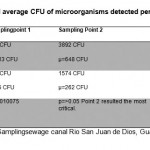 |
Table 1: Frequency and average CFU of microorganisms detected per sampling point. Click here to View table |
The sampling point no. 1 was selected with 89 Colony Forming Unit of Enterobacteria, and a mean of the 15 Colony Forming Unit of Enterobacteria at summer and a mean of the 125 Colony Forming Unit of Enterobacteria. In the sampling point no. 2 presented a break point with the 265 Colony Forming Unit of Enterobacteria and the mean of 44 Colony Forming Unit of Enterobacteria at the summer. At the autumn, the Colony Forming Unit of Enterobacteria was 21 and the point 3 was detected 116 Colony Forming Unit of Enterobacteria with the mean 19 Colony Forming Unit of Enterobacteria at summer and Colony Forming Unit of Enterobacteria was 103 with mean of 17 at the autumn (Figure 1).
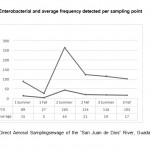 |
Figure 1: Enterobacterial and average frequency detected per sampling point Click here to View Figure |
We identified 723 strain of enterobacteria with a mean 462 Colony Forming Unit of Enterobacteria at the summer and a mean of 261 Colony Forming Unit of Enterobacteria at the autumn belong 18 genres and 40 species (Table 1). They had beta hemolytic proprieties with 48 strains belong 13 genrs and 20 species both seasonal summer with the 39 and 9 autumn (Table 2).
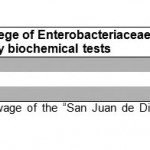 |
Table 2: Frequency and percentege of Enterobacteriaceae detected and identified by biochemical tests Click here to View table |
They had resistance to antibiotic with 24 strains resistance to antibiotic (68,57%) according to antibiogram test conducted on 35 strains. Theses enterobacterial had different spectrum of resistance to antibiotic, thus one strain was resistance to two antibiotics (2.85%), and three strains were resistance to one antibiotic (8.57%). Salmonella I strain was resistance to 12 antibiotics. Some strains showed sensitiveness to 12 antibiotics (20.0%), (Table 3).
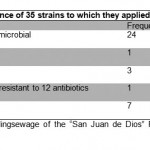 |
Table 3: Antimicrobial resistance of 35 strains to which they applied the antibiogram Click here to View table |
The strains isolated showed resistance to Nitrofurantoine (71.0%), Pefloxacine (60.0%), Amikacine (48.5%), Cloranfenicol (42.8%), Carbeniciline (40.0%), Ampicilin (37.1%), Cefotaxima (25.7%), Netilmicine (25.7%), y Trimetoprim-Sulfametoxazol (8.5%), (Figure 2). The strains resistance to antibiotics were Enterobacter cloacae, Edwarsiellaictaluri, Samonellaparatyphi and serotype I Salmonella, and Rahnellaacuatilis was resistance to pefloxacine.
The resistance to heavy metals as Pb, Cd and Cr was identified on 32 strains. A 9.3 % of strains were resistance to Pb, they were growth to 207ppm concentration of heavy metal, and another bacteria growth to 20.7 ppm of metal (90.6%). 15.6% of strains were resistance to Cd and they were growth to 112ppm concentration of metal, and 21 strains growth to 11.2 ppm concentration of metal (65.6%). The resistance to heavy metals were also minor to some strains, thus they were growth to 0.0112 ppm of heavy metals concentration (3.12 ppm), and another bacteria growth minor concentration of heavy metals (6.25%), and three strains (9.3%) could not grow in the concentration of heavy metals, and they were cataloged as sensitive to them 28 strains were resistance to Cr and they were growth to 10.4 ppm (87.5%) of concentration of heavy metal, or they were growth to 1.04 ppm (3.12%) , and some bacteria were not resistance to heavy metal (Table 4).
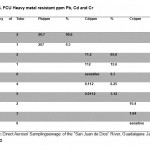 |
Table 4: FCU Heavy metal resistant ppm Pb, Cd and Cr Click here to View table |
Discussión
Seasonal variation, regarding the microbial concentration in the environment is determined by the own factors of each of the seasons. In this way, we could make reference to global climate changes expressed though the modification of the average temperature as well as the force and orientation of winds, as well as the growth and development of typical endemic plants.14
Bacterial findings collected through air sampling and study were directly associated to the aerosols which are generated from sewage water, whose sanitarian design also influences in a meaningful way, due to the particularities that the cannel represents, there are sectors that are irregular in their topography. These differences in their construction are more prominent particularly in sampling point 2, which has a cascading decline and the binding of a secondary channel for the same; this is where they had the highest number of microorganisms which significantly exceeds 1x103 bacilli Gram negative/M3 that determines the start of the presentation of adverse effects to human health. Moreover, at points 2 during the summer and autumn, this limit was exceeded but to a lesser extent in a seasonal way.
It is worth mentioning that, during summer much more enterobacteria were identified, whose biodiversity is an important advantage for practical use, and that can be used as biological indicators of environmental pollution because, by the nature of their habitat in the human gut, or other animals, as well as the respiratory tract, represent in person the continuing cyclical interaction in the health and environment management of their own waste products that are generated from the corresponding physiological actions, but which, however, impact the stability as the current sewage waters which have become the old "San Juan de Dios " River, as a natural reservoir whose cause, partially covered, passes through densely populated areas of the city of Guadalajara Jalisco Mexico (Table 1).
Moreover, one of the most highlighted of the present research is the findings about bacteria such as RahnellaAcuatillis whose particular niche is water. However, those bacteria were isolated from aerosols generated by wastewater and which as part of their phenotypic profile, their synthetic capacity of enzymes beta-hemolytic is highlighted, as well as its edema of high resistance to heavy metals like Pb to 207ppm, Cd to 112 ppm, Cr to 104 ppm and their resistance to PEF, besides the presence of Escherichia Blattaewhose normal niche constitutes the intestinal track of cockroaches and in whose strain beta hemolytic capacity was found, besides the presence of Salmonella biotype 1with an hemolytic profile and a multiple resistance to 12 antimicrobial.
Finally the ecological-environmental meaningful findings of multiple airborne bacterial species that presents high resistance to heavy metals is also meaningful because apart from their presence in the air is considered as biological indicators of environmental pollution.
At the same time, they also acquire additional usage value in order to function as bio-indicators of chemical pollution. This, under the dynamic interaction that is maintained in its environment, under extreme conditions, as are the industrial wastes that contain metallic residues which stimulate the environmental typical micro flora that acquires high resistance levels towards the same as part of a natural response to their adaptation and ulterior survival in the aerosols generated from the waste water and which allow to regulate their own virulence factors (21,22,23), having an impact on the manifestation of health risks of inhabitants who live nearby these type of environments.
The speech employed by the interviewees reflects for instance, the meaning of pollution associated with environmental conditions present in their community, which indicates that one must pay attention to this type of problems that show the causes of the problems to a public health level in which it is necessary to work focusing on sanitization problems from an environmental methodology, trying to find the control or elimination of risks associated to environmental conditions, which if we remember have an impact on the virulence of bacteria as well as on human health(22). The Evolution of Yersinia pestis of speciation from an environmental, non-pathogenic ancestor is a good example of the evolution steps that are involved in the emergence of bacterial pathogens. This process began with the acquisition of the plasmid pCD1 by environmental Yersinia.This process is fully explained Wren (2003), Keim and Wagner (2009) (23) hence the importance of living in a healthy environment, not laden bioaerosols contaminated with Enterobacteriaceae.
The air transport of virulent microbiological agents, as well as the density of antibiotics and resistant bacteria may enhance the adverse effects on public health and environmental surroundings, hence the importance of considering the implementation of inter hospital epidemiology And at the community level by exposure of virulent organisms,as they impact on human health in the family economy and health care.
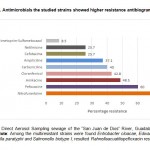 |
Figure 2: Antimicrobials the studied strains showed higher resistance antibiogram. Click here to View Figure |
Conclusions
- It is feasible to recover enteric microorganisms in aerosols generated from sewage, through the methodology employed in this study.
- During the summer season, a high quantity and biodiversity of enteric strains was identified, particularly at the second sampling point.
- The estimated concentration was higher than 1x103/M3, besides classical strains and the virulence factors identified, which suggests there is a social-ecological relationship with the inhabitants of neighboring communities to sewage waters.
- There is a relationship between the "topographic" design sewage and the amount of airborne Entero bacteria.
- The presence and characteristics of resistance to antibiotics and heavy metals in some entero bacteria strains allows us to propose them as bio-indicators of environmental, microbiological, chemical pollution and as indicators of risk to human health.
Acknowledgements
The authors of the present research article would like to acknowledge and truly thank the collaboration of Yesenia Elizabeth RuvalcabaCobián who has a B.A in Teaching English as a Foreign Language, for her contributions on the revision and translation of the article; situation which allows the possibility to increase the transferring and modification of scientific knowledge. The authors declare that no conflict of interests for the publication of this research paper.
References
- Gonzalo Gutiérrez. (1994).TheNationalProgram to Control DiarrhealDiseases: itsimpactonhealth and healthservices;Salud Publica Mex. vol. 36(2):127-128.
- Kirchner M, Abuoun M, Mafura M, ET AL (2013) Cefotaxime Resistant Escherichia coli Collected from a Healthy Volunteer; Characterisation and the Effect of Plasmid Loss. PLOS ONE 8:1-8.
- Ajami N.J., Kavanagh O.V., Ramani S. ET AL. (2014) Seroepidemiology of norovirus-associated travelers' diarrhea. Journal of Travel Medicine 21:6-11.
- Levine M, Ferreccio C, Prado V, et al (1993) Epidemiologic studies of Escherichia coli diarrheal infections in a low socioeconomic level peri-urban community in Santiago, Chile. Am J Epidemiol 138:849-69.
- Dekate P., Jayashree M., and Singhi S.C. (2013).Management of acute diarrhea in emergency room. Indian J Pediatr 80:235-246.
- Ansari S., Sherchand J.B., Parajuli K. et al. (2012). Bacterial etiology of acute diarrhea in children under five years of age.J Nepal Health Res Counc 10:218-223.
- Larrosa-Haro A., Macias-Rosales R., Sánchez-Ramírez C.A., ET AL. (2010). Seasonal variation of enteropathogens in infants and preschoolers with acute diarrhea in western Mexico. J PediatrGastroenterolNutr 51:534-536.
- Matthew A. Croxen and B. Brett Finlay (2010). Molecular mechanisms of Escherichia coli pathogenicity. Nature Reviews Microbiol 8, 26-38
- James B. Kaper, James P. Nataro and Harry L. T. Mobley. (2004).Pathogenic Escherichia ColiNature Reviews Microbiol 2, 123-140
- Donnenberg and KaperJ.B. (1992)EnteropathogenicEscherichia coli. InfectImmun 60 (10): 3953-3961.
- Amábile-Cuevas C. (2010). Antibiotic resistance in Mexico: a brief overview of the current status and its causes. J Infect Dev Ctries 4:126-131.
- Lighthart B, Shaffer BT. (1995).Airborne Bacteria in theAtmospheric Surface Layer: Temporal Distributionabove a GrassSeed Field.ApplEnvironMicrobiol. 61(4):1492-6.
- Olorunmola FO, Kolawole DO, Lamikanra A. (2013).Antibioticresistance and virulence properties in Escherichiacoli strains from cases of urinarytractinfections.Afr J InfectDis. 7(1):1-7.
- Kruse H, Sørum H. (1994).Transfer of multipledrugresistanceplasmidsbetween bacteria of diverseorigins in natural microenvironments.ApplEnvironMicrobiol. 60(11):4015-21.
- Wolman A. (1976): El medio ambiente y las enfermedades. Boletín de Oficina Sanitaria Panamericana, 81 (5) Nov. 455-461.
- Rosas I. A. Yela y C. Santos-Burgoa. (1994): Occurrence of airborn enteric bacteria in Mexico City. Aerobiología, 10(1); 39-45
- WalterS.D. (1991). The Ecologic Method in the Study of Environmental Health. I. Overview of the Method. Environmental health Perspectives 94 61-65.
- Walter SD. (1991). Theecologicmethod in thestudy of environmentalhealth. II. Methodologicissues and feasibility.EnvironHealthPerspect. 94:67-73.
- Stewart SL, Grinshpun SA, Willeke K, Terzieva S, Ulevicius V, Donnelly J. (1995). Effect of impact stress on microbial recovery onan agar surface.ApplEnvironMicrobiol. 61(4):1232-9.
- Roszak DB, Colwell RR. ( 1987). Survival strategies of bacteria in the natural environment.Microbiol Rev. 51(3):365-79.
- Cornejo-JuárezP., Velásquez-Acosta C., Sandoval S., Gordillo P., ET AL. (2007). Antimicrobial resistance patterns of isolates from urine cultures at an oncological center. Salud Publica de Mex. 49:330-336.
- Navarro-Navarro M., Robles-Zepeda R.E., Garibay-Escobar A., Ruiz-Bustos E.(2011). Hospital and community-acquired b-lactamasas-producing Escherichia coli and Klebsiellapneumoniae at hospitals in Hermosillo Sonora. Salud Pública de México. 53: 341-344.
- Martínez JL. (2013).Bacterialpathogens: from natural ecosystems to human hosts.EnvironMicrobiol. 15(2):325-33. doi: 10.1111/j.1462-2920.2012.02837







